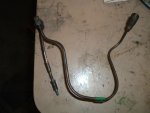I wondered at the time whether it might be a factory mod to slow the flow, but the flow was not happening at all in this pipe. Presumably it had in the past, but maybe all my fiddling dislodged it enough to block the flow completely.
I've obtained enough pipe and fittings to repair this one now, and I plan to leave the wire out on the basis that I don't reckon it really should be there.
All the linkages seem to be doing exactly what they should do, and the HC was checking out fine. I did as you suggested in that I disconnected the HC from the linkage and operated it manually. It would pump the struts up fine, but not release the pressure to let them come down again. (Note that I had lumps of wood under the jacking points ready to catch the beast should rapid dropping occur. I value my squashy appendages!)
This test first led me to suspect the pipe was blocked, and gradually undoing the pipe fitting at the HC proved it to me as the pressure was able to be drained from there into a bucket.
If the rain eases up enough I'll be able to prove things one way or another today.
Incidentally, has anyone had success with reclaiming LHM that's been drained this way? The container I drained it into was clean, but the fluid probably picked up a bit of dirt off the chassis on the way into the bucket. I reckon if I filter it through (say) coffee filter paper or maybe paper towel then it should be good. (Leaving the last centimetre or so in the bucket with all the larger lumps) Maybe not good enough for the purists, but this stuff is too expensive to just throw away without having a go I reckon.
Thanks for the responses so far, I really appreciate the input to the cogitative processes.
I've obtained enough pipe and fittings to repair this one now, and I plan to leave the wire out on the basis that I don't reckon it really should be there.
All the linkages seem to be doing exactly what they should do, and the HC was checking out fine. I did as you suggested in that I disconnected the HC from the linkage and operated it manually. It would pump the struts up fine, but not release the pressure to let them come down again. (Note that I had lumps of wood under the jacking points ready to catch the beast should rapid dropping occur. I value my squashy appendages!)
This test first led me to suspect the pipe was blocked, and gradually undoing the pipe fitting at the HC proved it to me as the pressure was able to be drained from there into a bucket.
If the rain eases up enough I'll be able to prove things one way or another today.
Incidentally, has anyone had success with reclaiming LHM that's been drained this way? The container I drained it into was clean, but the fluid probably picked up a bit of dirt off the chassis on the way into the bucket. I reckon if I filter it through (say) coffee filter paper or maybe paper towel then it should be good. (Leaving the last centimetre or so in the bucket with all the larger lumps) Maybe not good enough for the purists, but this stuff is too expensive to just throw away without having a go I reckon.
Thanks for the responses so far, I really appreciate the input to the cogitative processes.

 Chris
Chris
